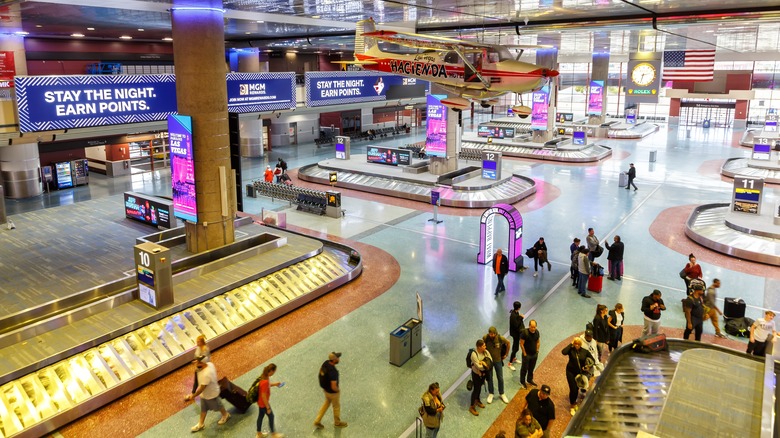This Western Airport Is The First In The US To Have TSA Self-Service Screenings
Going through TSA is one of the most daunting experiences whenever you fly. Apart from potentially facing the wrath of a TSA officer having a bad day, you have to brace yourself for queuing for what feels like an eternity and then perform a frantic unpacking of electronics and liquids — unless you were smart enough to have signed up for TSA PreCheck. You also have to keep yourself in check the entire time, since you might get flagged for doing an involuntary reflex. Fortunately, the TSA is trying to ease our collective pain with the introduction of the self-service screening system, trialing at Las Vegas' Harry Reid International Airport (LAS) since March 2024.
The self-service screening system is exactly what it sounds like — you go through the TSA security checkpoint without the usual verbal scolding for that laptop you forgot to take out of your bag. As of this writing, it's exclusive to LAS, but only because it houses the TSA's sole Innovation Center, which was erected in 2019 to function as a playground for new technologies. "The Innovation Checkpoint... is an exciting initiative that provides TSA with the unique opportunity to demonstrate multiple solutions and capabilities by various vendors in one physical environment without interrupting current airport operations," Austin Gould, TSA Assistant Administrator for Requirements and Capabilities Analysis, said in a press release at the time. So, if you want to see what the future of airport security might look like, book your next flight out of LAS.
How the self-service security check at LAS works
The TSA's new self-service system aims to make airport security as hassle-free as self-checkout at your local grocery store. It's not necessarily designed to make the process faster, but rather to make security a more pleasant experience for all travelers. "Individuals want to be able to complete the screening process at their own pace and with minimal interaction with our officers," Christina Peach, TSA's deputy assistant administrator for requirements and capabilities, told The New York Times.
When you step up to the self-service kiosk, you'll be greeted by a user-friendly screen outlining the steps, and should you find anything confusing, just tap on the "Need Help?" button to video chat with a TSA officer virtually in real-time as if you're on FaceTime. Next, you'll pop your stuff into a single bin, push it onto the conveyor belt, and stride through the full-body scanner that flags items of concern. If you're flagged, step back, remove the culprit items, and try again. Once you're all clear, grab your items from the bin. And here's the kicker: You don't even need to return the bin yourself. It rolls itself back when it's completely vacant, reducing the chances of leaving anything behind.
At this time, the self-service security check is exclusive to those with TSA PreCheck and is only available from 5:30 am to 1:30 pm. If you're traveling with kids under 12 or require special assistance, you might need to stick to the standard lanes.
You can expect more self-screening lanes in the future
As with any pilot program, rolling out the TSA's self-service security screening nationwide isn't a done deal yet. The TSA will still have to gather more feedback from travelers and work out any kinks that have been reported. "We're expecting there to be some challenges. The question is: How easy will those challenges be to resolve?" John Fortune, the Department of Homeland Security's Screening at Speed program manager, explained to The Washington Post. "It can be an iterative process where we hopefully get a system that is seamless enough that it could be rolled out to the traveling public."
There's always a chance that this program might not take off beyond the confines of LAS — or it could be a success, becoming a new norm at airports across the country. But if it does catch on, don't expect it to happen overnight. Adoption could be slow, especially among first-timers and those who don't fly often. "It's going to take time to educate the public," Keith Jeffries, a former TSA director at Los Angeles International Airport, told the Associated Press. "I think eventually we'll see more and more of them."
TSA may also decide to trial even more innovative technologies and procedures that differ from what's being tested. But one thing is clear, as Rosemary Vassiliadis, Clark County Director of Aviation, said at the launch of the Innovation Checkpoint, "What happens in Vegas won't stay in Vegas."

